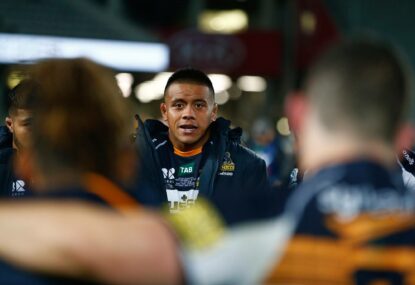
Australian rugby union backs Quade Cooper, Adam Ashley-Cooper, James O'Connor, Matt Giteau and Drew Mitchell. AAP Image/Paul Miller
With senior figures from the rugby world’s governing bodies having met at their yearly summit, I’d like to weigh in with an opinion on how the problems in the game should be addressed.
Before you can fix a problem, you must first decide exactly what the problem is and then what is causing it.
Once this is agreed, then potential solutions can be formulated, discussed and hopefully agreed upon.
Essentially there are two styles of play in the game and their differences are based around the importance placed on either kicking and running as the primary means of gaining points.
Ideally, there would be a balance between the two, where on any given day a team practising one style or the other may give themselves a realistic chance of winning a particular match so long as they were able to implement their own style well enough while countering the other style effectively.
These multiple paths to potential success are a large part of rugby’s unique character as well as its point of difference with games such as rugby league, which is largely one dimensional in comparison.
At this point, based on the test matches played over the last few years, going back to the last World Cup, the balance seems to have drifted too far to the kicking style and it has become too difficult to consistently implement the running style.
You might say that the performances of Australia and New Zealand in beating Wales and France show that running rugby is still alive and well, but one (or two) swallows does not a summer make and it cannot be denied that even these nations have found it difficult to consistently implement a successful running rugby style for some time.
It would be foolish to ignore a general trend in the game on the basis of two outstanding team performances and it must be noted that these two games represent these teams best performances over recent times.
It should also be noted that although these two games were no doubt entertaining, in both games only one side was able to score a touchdown with the traditional entertainers of the northern hemisphere, France and Wales, kept tryless over both matches.
Rugby as a game should contain a greater margin for error for teams attempting to play running rugby.
An international professional team should not have to perform at their absolute peak in order for entertaining rugby to occur and even teams being dominated should still be able to expect some reward for running with the ball, if not by winning then at least by scoring the occasional try.
The reason for the drift towards the kicking style lies primarily with the increasing professionalism of the game to the point where defending professional players are now unlikely to misread a play or miss a tackle to the extent that a break can be made.
A more likely result is that the player will be tackled at the first line of defence with little or no ground made.
Repeatedly retaining possession without forward momentum is extremely difficult and as a result, in a static ruck situation (ie. a ruck in which the defence has had sufficient time to set/align itself) the perceived risk of running the ball, this being conceding a turnover or penalty, is now much higher than the likely benefit.
Combining with this increased ability of defenders in the first line is the increased ability of the second line to scramble once the initial break is made as well as their ability to regroup and organise an effective line once the initial break has been halted, quickly creating another a static ruck situation for the attack, from where it must find a way of making a rare break once again.
A final factor increasing the risk and reducing the likely benefit of running the ball is the fact the team of a player making a line break is put at an immediate disadvantage.
Once the attacking player making the break is involved in a one on one tackle the tackler may, after making the tackle, get to his feet and retrieve the ball while the tackled player must lie on the ground and release the ball to him.
Assuming that on average the numbers of the arriving support players from either side will cancel each other out after the break the defending side will retain the advantage of numbers at the ruck.
The usual method to counter this is for players to carry the ball behind them and shield it with their body into the impact to ensure they fall with their body between the opposition and the ball.
It becomes much more difficult to do this while running at full pace trying to capitalise on a break however (or even hitting a half gap at pace trying to make the break for that matter) and turnovers or penalties against the attacking team often result from these breaks.
Slowly but surely gaining enough ground to score a try by keeping the ball in hand has become almost impossible. Just think, when was the last time you saw a test match try scored by a team making a succession of small advances.
Very rarely is my answer. If a team is good enough to make a half break gaining 10 or 20 metres then they risk at best having to start again and make another extremely difficult break in the defensive line or at worst become isolated and penalised.
Tries by running the ball almost always now involve a long range effort with a solitary sweeping movement or perhaps one quickly recycled ruck.
This is fine if these sweeping movements are happening with frequency but unfortunately they are not because the initial break is so difficult to make.
Additionally this style of play naturally favours teams with better backlines.
As a result teams with a dominant forward pack but little in the way of backs are forced to employ the kicking style of game as there is no viable alternative running game style available to them which again reduces the games depth.
From the above it seems clear that the focus of any discussion of rule tweaking should have as its key aim adjusting the balance between the risks and benefit of running the ball such that it produces a game which is entertaining to both play and watch and simple to officiate, while ensuring the game retains its depth by both allowing for different methods of successful running but also by not making tries too easy to score and killing off tactical kicking (including drop goals).
Obviously the balance is a delicate one.
Assuming it can be agreed that this balance is the key problem with the game, a systematic review of the key reasons that the balance is not where it should be must then be made.
In order to conduct this systematic review a panel of thinkers should be convened representing the games key stakeholders, these being players, coaches, spectators (represented by journalists) and match officials all taken from the professional ranks.
This panel would then analyse the game and determine the key factors which have caused the risk/benefit balance of running the ball to not be currently correct.
With any luck, they will come up with the factors I have discussed above plus some more.
Once this is phase is completed a list of potential amendments should be drafted to address these factors (say, for example, holding the defence offside until the ball touches the hands of the first receiver or is run by the nominal halfback – my idea).
Following this, a list of likely outcomes, good and bad, should be drafted for each proposed change (eg. difficult for players to adjust, would create additional attacking forward momentum etc).
This list should then be passed around and each outcome should be extensively discussed and then given a relative score by each stakeholder in terms of the likelihood/frequency of the outcome occurring and the desirability of the outcome.
Scores would then be plotted on a square grid with highly likely/frequent highly desirable outcomes in one corner and highly unlikely/infrequent highly undesirable outcomes in the other, giving a clear picture of the likely results of the change.
The outcomes could be plotted together to give an overall image of the particular modification as well as viewed separately for each outcome.
At the end you would have produced a set of potential game adjustments each with a relatively simple picture of what would happen were that change implemented.
The changes and outcomes could then be clearly reviewed and considered for implementation.
This full and clear picture allows specific selection for the level of tweaking required to achieve a slight adjustment of the risk/benefit balance (or massive change for that matter if that was what was wanted).
As I implied earlier the choosing of specific changes for implementation would be a delicate balancing act.
For example, a proposed change would not necessarily need to have completely desirable outcomes if the undesirable outcomes were believed to be highly unlikely or infrequent.
Also it may be felt that a change with a high density of highly likely highly desirable outcome could push the balance too far.
The provision of visual representation would allow the selection of one or more modifications which were felt to tweak the balance correctly.
The above process is not that far removed from common risk assessments undertaken in many industries today and there are many variations.
The specific process which is undertaken need not necessarily be precisely as I’ve detailed, however, considering the complexity of the game and the number of stakeholders the game has around the world, it is crucial that some kind of systematic approach be employed in the modification of its rules.
It goes beyond the process just facilitating easier selection of changes. It provides a level of confidence in the change selection and justification of the selection to stakeholders as well as facilitating future assessment of its success and failure (ie if the anticipated outcomes do not occur or additional undesirable outcomes do occur).
The process is likely to be required again periodically in any case as the game changes further under the professional era and having a system in place will facilitate ongoing adjustment.
Most likely each round will bring the game closer to a kind of rule stability.
I must say that with a clear breakdown of the specific problem in the game it is hard to understand how the implementation of this most recent rule of allowing the first player to get his hands on the ball at a ruck (almost always a defender) to keep hold of it will improve things.
I’m not privy to the process involved in developing this new rule but when you think about its likely impact and compare it to the actual specific problem it seems to me that it was done without a clear objective in mind and its suggestion and implementation demonstrates the hit and miss nature of not having a systematic approach to rule modifications.
A meeting of national governing body heads over a few days is not an appropriate forum to debate means of improving the game through rule changes.
Current professional players and coaches and match officials (and even journalists) are best placed to understand and predict likely impacts in the modern game and would require a significant time period to think and debate.
A group of old men who all played in the amateur era hanging out in a boardroom for a few days just won’t do it.
They should really be just reviewing recommendations received from a specialist forum.
Then again, maybe one of them will just come up with a great idea which will fix everything.
I reckon my offside rule would do the trick.


































































































